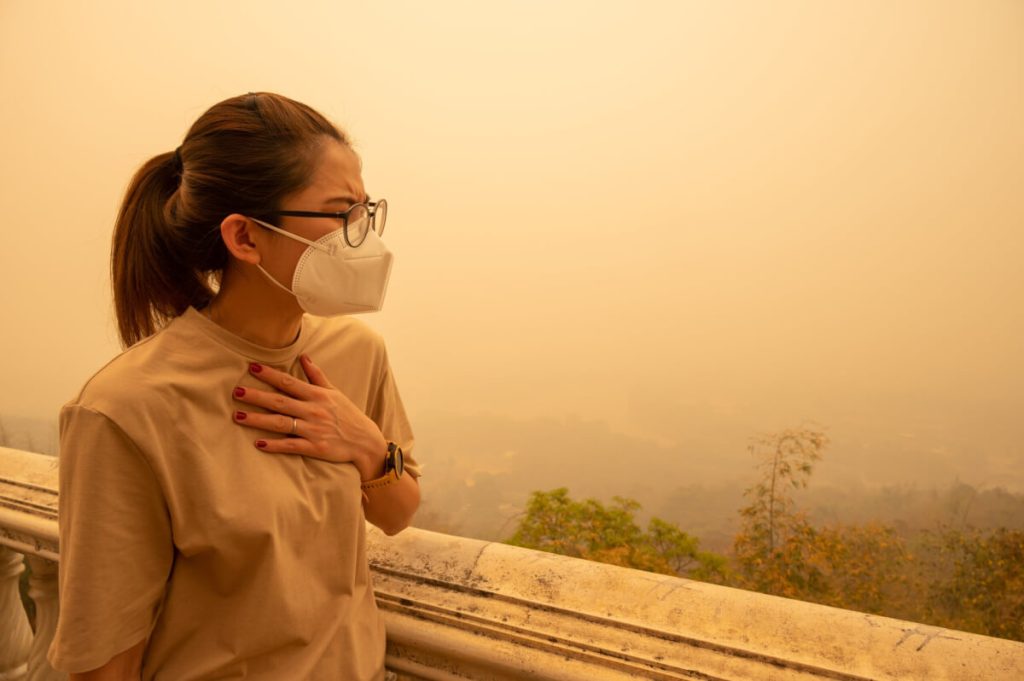

Exposure to the chemicals in wildfire smoke are harmful to human health long after the smoke clears. (Boyloso/Shutterstock)
In a nutshell
- A single day of wildfire smoke can contribute over 20% of toxic pollutants that accumulate on urban surfaces over months
- These pollutants (PAHs) don’t wash away or break down easily, creating a lasting toxic reservoir that can affect human health through contact with contaminated surfaces
- Even small local fires have major impacts – a single backyard fire in Kamloops produced three times more toxic pollutants than all other sources combined during the study period
HAMILTON, Ontario — Wildfire smoke doesn’t just darken our skies while the flames rage on; the toxic pollutants it carries pose a longer-lasting threat than many realize. These chemicals don’t simply disappear when the air clears. Instead, they settle onto buildings, windows, and other urban surfaces. There they can remain for months, potentially affecting human health long after the air appears clear.
The urgency of understanding these lingering effects has never been greater. Canada’s 2023 wildfire season was the most destructive ever recorded, with an estimated 18.5 million hectares burned. The 2024 season followed as the second worst, with more than 5 million hectares consumed according to the Canadian Interagency Forest Fire Centre.
A new study led by researchers at McMaster University reveals that a single day of wildfire smoke can contribute over 20% of certain toxic pollutants that accumulate on urban surfaces during a typical fire season. These findings, published in Environmental Science & Technology, highlight how increasing wildfires may impact public health in cities, even ones located hundreds of kilometers from the flames.
The study focused on measuring polycyclic aromatic hydrocarbons (PAHs) in what scientists call “urban grime.” PAHs are a family of chemicals produced whenever materials don’t burn completely, whether in a forest fire, backyard barbecue, or car engine. Many PAHs are known to cause cancer and other health problems. This grimy film that builds up on outdoor surfaces is more than just dirt. It’s a complex mixture of pollutants that can capture and release harmful compounds that persist for months or even years.


“This study was motivated by the large increase in wildfire frequency and severity in Western Canada,” explains lead author of the study Iris Chan from McMaster University, in a statement. “There is a great deal of public awareness and research on air quality related to North American wildfires, but the long-term impact of smoke drifting into cities is virtually unknown.”
To investigate this impact, researchers enlisted volunteers in Kamloops and Calgary to collect samples in their backyards from August to November 2021. They used specially designed kits containing glass beads that mimic how pollutants accumulate on building surfaces over time. The team regularly collected and analyzed these samples while also monitoring local air quality measurements like carbon monoxide and fine particulate matter to track wildfire influence.
The results were striking. In Calgary, when smoke from Saskatchewan wildfires reached the city on October 6, 2021, it led to a dramatic spike in PAH levels, contributing more than one-fifth of the total PAH pollution measured during the entire study. These pollutants traveled approximately 500 kilometers to reach the city, demonstrating how far wildfire impacts can extend. More concerning still, while air quality returned to normal after the smoke cleared, the elevated PAH levels in the urban grime persisted for weeks afterward.
The situation in Kamloops revealed how even small local burning can have outsized effects. The researchers detected a sharp increase in PAH levels that wasn’t associated with any major wildfire activity. Based on the specific chemical signature of the pollutants, they determined this spike came from a nearby wood-burning event, possibly something as simple as a backyard fire pit.


“We should be mindful that the minor things people do every day, like using their barbeque or having a campfire in the backyard, can have a significant and long-lasting impact on their local environment,” says study supervisor Sarah Styler, Canada Research Chair in Atmospheric Chemistry at McMaster.
The research raises important health considerations, particularly in regions experiencing increased drought. Without sufficient rainfall to wash away the grimy buildup, these toxic reservoirs can accumulate for extended periods.
“We would then expect precipitation to release pollutants into stormwater runoff, with the potential for adverse consequences for downstream water bodies, sediments, and aquatic life,” says Styler.
Children may be particularly vulnerable to these persistent pollutants. The study notes that kids playing on outdoor equipment could absorb PAHs through skin contact or hand-to-mouth transfer after touching contaminated surfaces. While more research is needed to fully understand these exposure risks, the findings suggest we should consider not just air quality during smoke events, but also the lasting contamination of surfaces children frequently touch.
The implications extend beyond human health. The research team found that PAHs in urban grime remained remarkably stable over time. They didn’t break down when exposed to sunlight or normal weather conditions. This stability means these pollutants can accumulate over extended periods, potentially creating a growing reservoir of toxins that could be released into the environment during heavy rains.
As wildfires become more frequent and intense, cities may face not just more smoke events, but also an increasing buildup of persistent pollutants on their surfaces. This could be especially problematic in regions that experience both increased fire activity and drought conditions, where pollutants might accumulate for longer periods without being washed away.
The research team is expanding their investigation, currently analyzing samples from multiple cities in Canada and the United States collected during the 2022 wildfire season. They’ve also begun a pilot project with Environment Hamilton to analyze dust and grime samples in city neighborhoods, helping determine pollution distribution patterns and composition across different areas.
The study measured 13 different PAHs plus one additional compound specific to wood burning, but this likely underestimates the total impact of wildfire smoke on urban surfaces. Many other pollutants weren’t included in the analysis, suggesting the full spectrum of contamination could be substantially larger. Understanding this broader range of pollutants and their behaviors will be crucial as cities adapt to increasing wildfire activity.
As climate change drives more frequent and severe wildfires, understanding these lasting impacts becomes increasingly critical for urban environmental health. The evidence suggests that even brief smoke events can leave a toxic legacy that persists long after the skies clear, affecting both human health and environmental quality in ways that demand further study and potentially new approaches to urban environmental protection.
Paper Summary
Methodology
Researchers used a clever sampling system consisting of sheltered racks holding glass beads at various heights. These beads acted like tiny pollution catchers, accumulating grime just like building surfaces do. Samples were collected three times weekly from August through September 2021, then weekly until late November. The team used sophisticated chemical analysis techniques to measure 14 different PAH compounds in the grime samples.
Results
The study found that a single day of wildfire smoke in Calgary contributed over 20% of the total PAH pollution measured during the three-month study. In Kamloops, a local wood-burning event caused PAH levels to triple compared to background levels. The pollutants remained stable and didn’t show signs of breaking down over time.
Limitations
The research only measured a subset of possible pollutants and was conducted over a relatively short period in just two cities. Weather conditions and local factors could have influenced the results. The sampling method, while effective, may not perfectly represent how pollutants accumulate on actual building surfaces.
Takeaways and Discussion
This research reveals that wildfire smoke creates lasting pollution on urban surfaces that persists long after air quality improves. These findings suggest we need to consider not just immediate air quality impacts from wildfires but also longer-term contamination of urban environments. The study also highlights how even small local burning events can significantly impact nearby surface pollution levels.
Funding and Disclosures
The research was funded by McMaster University’s Department of Chemistry & Chemical Biology, the Faculty of Science, and the Natural Sciences and Engineering Research Council of Canada (NSERC). Additional support came through the Canada Research Chairs program.
Publication Information
This study was published in Environmental Science & Technology as part of a special issue on “Wildland Fires: Emissions, Chemistry, Contamination, Climate, and Human Health.” The research team included Iris Chan, Stephanie R. Schneider, Annie Cheng, and Sarah A. Styler from McMaster University.







